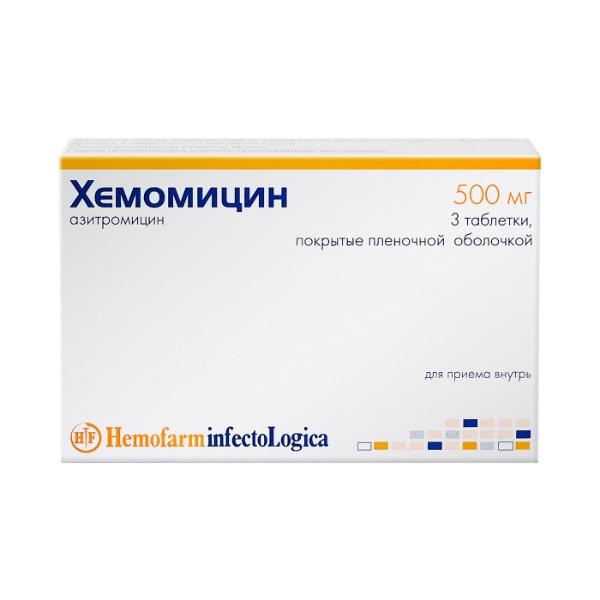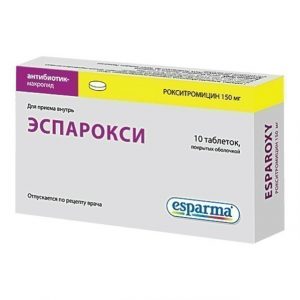Description
Description
Round, biconvex tablets, film-coated, grayish-blue.
Pharmacological action
Broad-spectrum antibiotic. It is a representative of the subgroup of macrolide antibiotics – azalides. In high concentrations it has a bactericidal effect. Gram-positive cocci are sensitive to azithromycin: Streptococcus pneumoniae, Streptococcus pyogenes, Streptococcus agalactiae, group C, F and G streptococci, Staphylococcus aureus, Streptococcus viridans gram-negative bacteria: Haemophilus influenzae, Moratelis peris catella Bordetella parapertussis, Legionella pneumophila, Haemophilus ducreyi, Campylobacter jejuni, Neisseria gonorrhoeae, and Gardnerella vaginalis, some anaerobic microorganisms: Bacteroides bivius, Clostridium perfringens, Perampreclomplamida pomplamida chlamidae Chlamyxophylidae, Chlamyxophylorhynchylum, Chlamyxophylorhynchylum, Chlamyxopterachlidae Azithromycin is inactive against gram-positive bacteria resistant to erythromycin.
Indications
Infectious and inflammatory diseases caused by microorganisms sensitive to the drug: Upper respiratory tract infections and ENT organs (tonsillitis, sinusitis, tonsillitis, pharyngitis, otitis media) Scarlet fever Lower respiratory tract infections (bacterial and atypical pneumonia) skin and soft tissues (erysipelas, impetigo, secondary infected dermatoses) Urogenital tract infections (uncomplicated urethritis and / or cervicitis) Lyme disease (borreliosis), for the treatment of the initial stage (erythema migrans) A disease of the stomach and duodenum associated with Helicobacter Pylori (as part of combination therapy).
Contraindications
Hypersensitivity (including to other macrolides) hepatic and / or renal failure children under 12 years of age (for this dosage form), lactation. With caution, pregnancy, arrhythmia (ventricular arrhythmias and prolongation of the QT interval are possible), in children with severe impaired liver or kidney function.
Use during pregnancy and lactation
During pregnancy, hemomycin is prescribed only when the expected benefit of the therapy to the mother outweighs the potential risk to the fetus.
If you need to use the drug during lactation, you should decide whether to stop breastfeeding while you are using the drug.
Special instructions
If you miss a dose of 1 dose, you should take the missed dose as soon as possible, and the next dose with an interval of 24 hours. You must observe a break of 2 hours while using antacids. After treatment is canceled, hypersensitivity reactions may persist in some patients, which requires specific therapy under the supervision of a physician.
Composition
1 film-coated tablet contains the active substance azithromycin 500 mg (in the form of azithromycin dihydrate) excipients – microcrystalline silicate cellulose – 69.00 mg, microcrystalline cellulose – 57.00 mg, carboxymethyl type A starch (sodium) 46.00 mg povidone – 24.00 mg, magnesium stearate – 10.00 mg, talc – 10.00 mg, colloidal silicon dioxide – 1.00 mg shell: titanium dioxide – 10.58 mg, talc – 9.57 mg, co-shaped – 4 , 95 mg, ethyl cellulose – 4.95 mg, macrogol 6000 – 1.32 mg, indigo carmine (indigotine) E 132 – 1.22 mg, green dye 8% (indigo carmine (indigotine) E 132, quinoline yellow E 104) – 0.41 mg
Dosage and administration
Inside, 1 hour before or 2 hours after meals, 1 time per day. Adults and children over 12 years old with infections of the upper and lower respiratory tract – 0.5 g / day for 1 dose for 3 days (course dose – 1.5 g). For infections of the skin and soft tissues – 1 g / day on the first day for 1 dose, then 0.5 g / day daily from 2 to 5 days (course dose – 3 g). In acute infections of the genitourinary organs (uncomplicated urethritis or cervicitis) – once 1 g. In Lyme disease (borreliosis) for the treatment of stage I (erythema migrans) – 1 g on the first day and 0.5 g daily from 2 to 5 days (course dose – 3 g). In gastric ulcer and duodenal ulcer associated with Helicobacter pylori – 1 g / day for 3 days as part of combination anti-Helicobacter therapy.
Side effects of the digestive system: diarrhea (5%), nausea (3%), abdominal pain (3%) 1% or less – dyspepsia, flatulence, vomiting, melena, cholestatic jaundice, increased activity of liver transaminase in children – constipation, anorexia, gastritis. From the cardiovascular system: palpitations, chest pain (1% or less). From the nervous system: dizziness, headache, vertigo, drowsiness in children – headache (with treatment of otitis media), hyperkinesia, anxiety, neurosis, sleep disturbance (1% or less). From the genitourinary system: vaginal candidiasis, nephritis (1% or less). Allergic reactions: rash, photosensitivity, Quincke’s edema. Other: increased fatigue in children – conjunctivitis, pruritus, urticaria.
Drug interactions
Antacids (aluminum and magnesium), ethanol and food slow down and reduce absorption.
When co-administered warfarin and azithromycin (in usual doses), no change in prothrombin time was detected, however, given that the interaction of macrolides and warfarin may increase the anticoagulation effect, patients need careful monitoring of prothrombin time.
Digoxin: increased digoxin concentration.
Ergotamine and dihydroergotamine: increased toxic effects (vasospasm, dysesthesia).
Triazolam: decreased clearance and increased pharmacological action of triazolam.
Slows down the excretion and increases the plasma concentration and toxicity of cycloserine, indirect anticoagulants, methylprednisolone, felodipine, as well as drugs, subjected to microsomal oxidation (carbamazepine, terfenadine, cyclosporine, hexobarbital, ergot alkaloids, valproic acid, disopyramide, bromocriptine, phenytoin, oral hypoglycemic agents, theophylline and other xanthine derivatives) – due to the oxidation of hepatocyte microsites
Lincosamines weaken effectiveness, tetracycline and chloramphenicol enhance.
Pharmaceutically incompatible with heparin.
Overdose
Symptoms: severe nausea, temporary hearing loss, vomiting, diarrhea.
Treatment: symptomatic gastric lavage.
Storage Conditions
In a dry, dark place at 15 to 25 ° C. Keep out of reach of children.
Expiration
3 years.
Do not use after the expiry date stated on the packaging.
Active ingredient
Azithromycin
Terms leave through pharmacies
In retseptu
lekarstvennaja form
tablets
Prescription
Pregnant as prescribed by the doctor, Children over 12 years old, Children as prescribed by the doctor, Adults prescribed by a doctor
Indications
Indications
From pharyngitis, From sinusitis, From skin infections, From tonsillitis, From cystitis, From otitis media, From urethritis, From infectious diseases, From sinusitis, From urinary tract infections, From pneumonia, From respiratory infections, From sore throat




